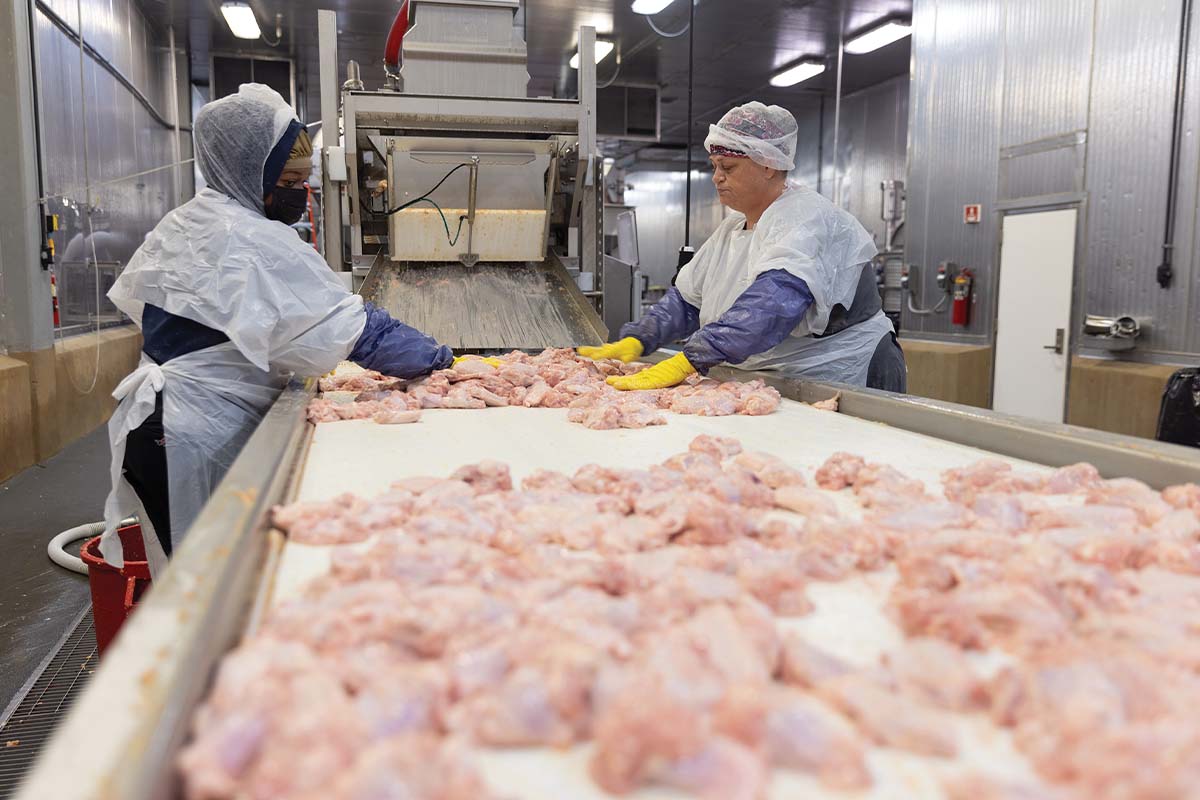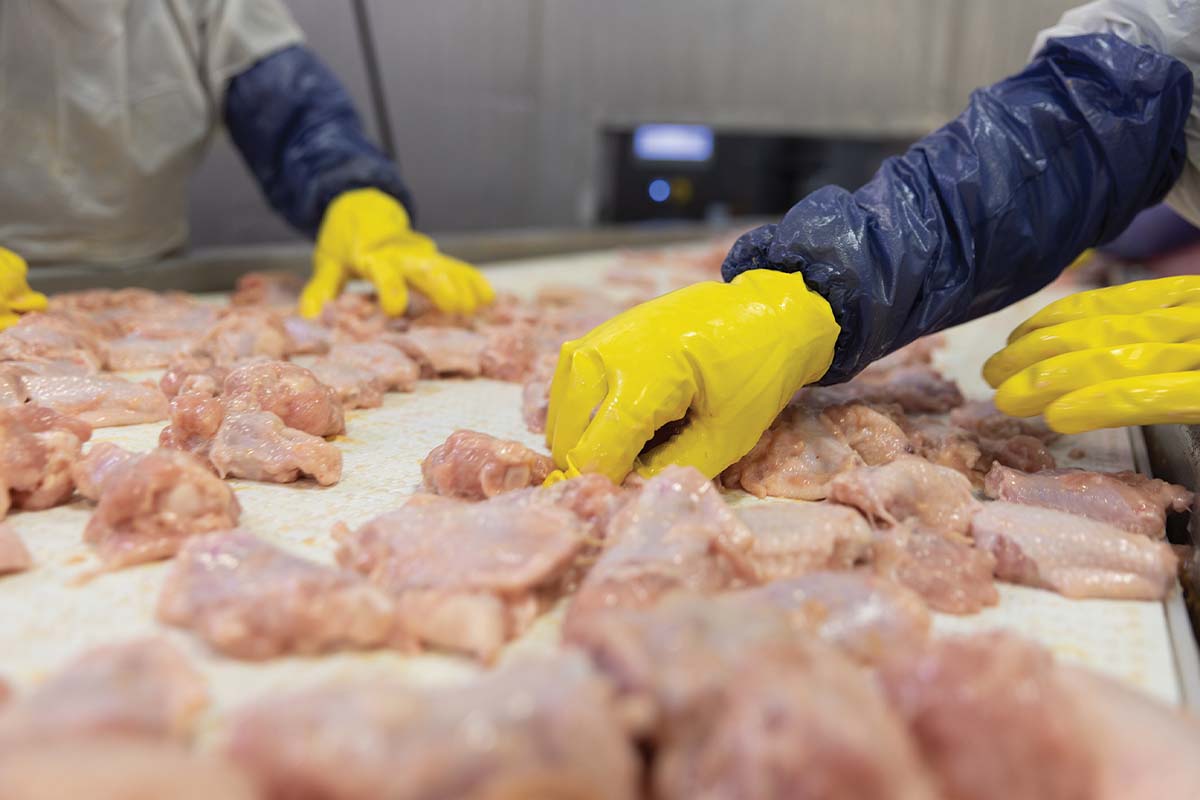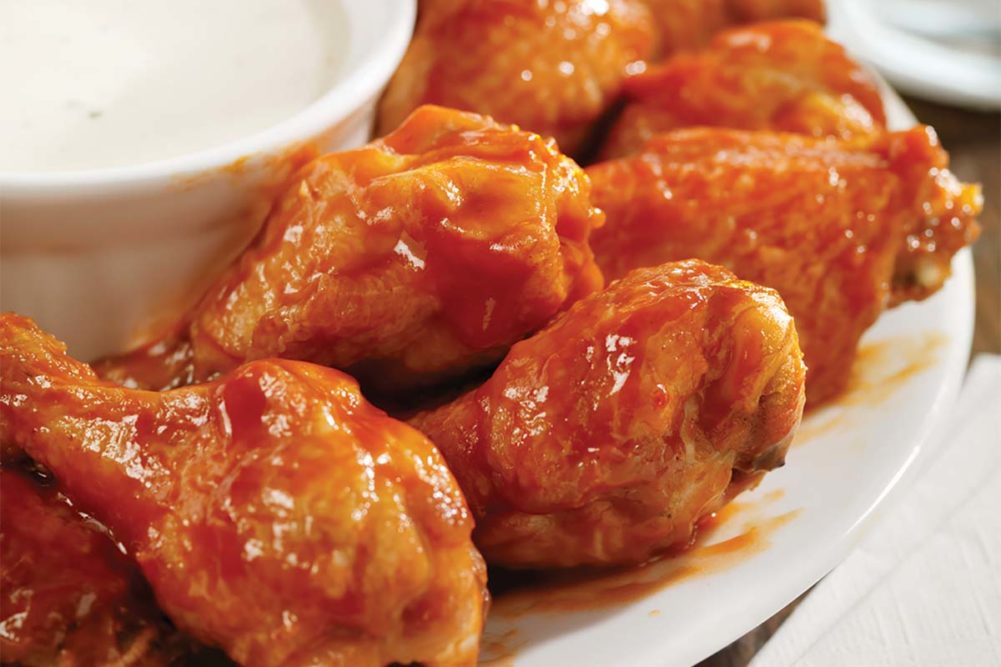Few items can be found on nearly every foodservice menu and transcend restaurant concepts and geographical lines, from fast-casual to QSRs, from the West Coast to the East Coast. And in the case of chicken wings, even restaurant chains base their names and reputations on the iconic fare. After years of popularity, chicken wings are still trending prominently and officials at Oakwood, Ga.-based Wayne-Sanderson Farms recognized this trend long before the August 2021 announcement that its parent company, Continental Grain Co. and Cargill planned to partner to acquire Sanderson Farms for $4.5 billion.
Just over a year ago, the company, now known as Wayne-Sanderson Farms began renovating about 18,000 square feet of its Decatur West Prepared Foods plant as part of a $26 million project to create a dedicated line for producing pre-cooked chicken wings specifically for foodservice. Just about 11 months after construction began, Line 51 was completed and operational, giving the company an additional 42 million lbs of chicken wing capacity.
Demanding wings
Chicken wing consumption has exploded beyond a staple at annual Super Bowl parties to a mainstay on a majority of foodservice menus in a variety of forms and flavor profiles.
“Restaurants have been a big driver in this growth with wings as appetizers on menus,” said Keri Hart, brand manager with Wayne-Sanderson Farms. “Also, the growth of wing specific chains like Buffalo Wild Wings have capitalized on this popularity. Wings have also successfully attached themselves as a favorite with sporting events such as football,” she added.
At a time when meat prices are at historic highs, chicken is also a more affordable option for many diners, not to mention its health attributes and the variety of chicken wing flavor profiles that appeal to a wide swath of consumers, Hart said.
“Chicken wings are satisfying because it’s a good source of protein, you can flavor them 50 different ways, they are a handheld eating experience and they taste amazing,” Hart said. “Chicken works well with many different flavors from spicy buffalo to sweet honey or even Thai chili.”
Meeting demand
Wayne Farms’ new dedicated chicken wing processing line at its 116,000-square-foot Decatur West Prepared Foods plant in Alabama has allowed the company to focus on expanding its production of a variety of pre-cooked, bone-in wings for a growing number of foodservice customers. The latest addition is the tenth production line in that plant, and it added about 80 employees.
Wings produced on Line 51 are precooked, either roasted or steamed and products include breaded, non-breaded and buffalo style. In a recent tour of the new facility, the plant was producing steam-cooked wings for foodservice at a capacity of about 13,000 lbs per hour.
Prior to the addition of Line 51, production of Wayne-Sanderson wings was being shared by three other lines, mostly on Line 53 at the company’s Decatur West facility. About half of the entire Decatur complex’s 1,000 workers are assigned to positions in its Decatur West Prepared Foods plant. The adjacently located Decatur East facility is 114,000 square feet. A cold storage facility is situated between the two operations. The Decatur complex includes the East and West plants that produce chicken-based items for foodservice and retail customers with offerings that include cooked, par-fried, marinated, sous vide, frozen and sausage products. The complex also houses the Wayne-Sanderson Farms Customer Innovation Center, a research and development culinary facility that includes a test kitchen that is equipped with commercial-grade kitchen equipment.
 Wayne-Sanderson Farms recently renovated about 18,000 square feet of its Decatur West Prepared Foods plant as part of a $26 million project to create a dedicated line producing pre-cooked chicken wings. (Source: Wayne-Sanderson Farms)
Wayne-Sanderson Farms recently renovated about 18,000 square feet of its Decatur West Prepared Foods plant as part of a $26 million project to create a dedicated line producing pre-cooked chicken wings. (Source: Wayne-Sanderson Farms)
Dedicated to wings
“We decided we would consolidate that volume because we had additional volume that was being commercialized and requested from customers, and that would have put us over capacity on Line 53 for wings,” said Heath Loyd, senior director of Decatur Prepared Foods.
Once the decision was made to add Line 51, that freed up Lines 52 and 53 to process more breaded and boneless chicken wing items, although at a lower volume.
“The Line 51 decision had arms with multiple angles to benefit customers and streamline the production,” Loyd said.
To keep up with demand, two FPEC tumblers with a capacity of 10,000 lbs each are positioned just above the staging area of the line. For the company’s roasted, steam-cooked chicken wings, the tumblers incorporate a marinade into the products.
After tumbling products are conveyed to a JBT-Stein, twin-drum oven, which has a capacity of 18,000 lbs per hour. For the steam-cooked products, the dwell time is approximately 17 minutes at temperatures between 175°F and 180°F. Cooking thousands of pounds of wings at a time and maximizing yield and quality is facilitated by uniformly distributing hot air across the spiral oven’s two rotating tiers. Wayne-Sanderson officials said the electric-powered oven operates more efficiently than thermal fluid-based systems that rely on oil and gas to operate.
After cooking, wings are conveyed to a mammoth GEA spiral freezer (the company’s biggest, in fact) where they are individually quick frozen before moving to the packaging area. Average production on the line is about 100,000 lbs per shift, typically dedicated to one specific SKU per shift.
Part of the highly efficient operation of Line 51 is due to the implementation of automation in the packaging area. In August operations in the pack out area were enhanced with the installation of automation technology, including robotic case-packing equipment, which will reduce the labor needed by about eight people per shift in the department where a total of about 36 workers are now employed.
“That is the first case-pack department in the complex that is fully robotic,” Loyd said.
“We are installing it here on our highest-volume line first,” he added, and plans are to apply the robotic technology, supplied by JLS, in other departments at the complex in the months to come.
Loyd, said that while the line is dedicated to chicken wings, the offerings are varied, with a product mix that includes as many as 30 SKUs.
“We have an ingredient deck for every type of wing,” Loyd said, using either a wet or dry marinade during the tumbling process.
The raw materials used on the new line are jumbo wings (six to eight wings per lb) that are typically sourced from birds weighing about 9.5 lbs. Production includes Wayne-Sanderson’s Crispy Fliers, Buffaloo and Flying Saucers in a variety of flavor profiles.
“We source all of the raw material internally from our sister facilities at Wayne-Sanderson,” Loyd said, including the Decatur Fresh plant for the Buffaloos (bone-in and boneless) and the nearby Albertville facility.
While most of the product is for foodservice customers, packed in two, 5-lb bags per case, Wayne-Sanderson also produces a limited volume of chicken wings for retail customers. Roasted and breaded products make up about 65% of the production on the new line, and steam-cooked varieties constitute the remaining 35% of the products.
The plant is currently running at 80% capacity and increasing steadily. With several new foodservice products currently in the pipeline, Loyd said that in the next several months the plant capacity will be operating at about 90-95%.
“Consumption is up and demand for prepared, easy-to-serve chicken has never been higher,” said Tom Bell, vice president of prepared foods at Wayne Farms. “With this new line, the opportunities for Wayne Farms and for our customers goes to a new level.”
 Raw materials used on Line 51 are jumbo wings (6-8 per lb) that are sourced internally from chickens weighing about 9.5 lbs. (Source: Wayne-Sanderson Farms)
Raw materials used on Line 51 are jumbo wings (6-8 per lb) that are sourced internally from chickens weighing about 9.5 lbs. (Source: Wayne-Sanderson Farms)
Flexibility pays off
As a brand manager, Hart said the products from Line 51 are designed to deliver on the diverse needs of today’s foodservice operators. She said most restaurants prefer a blank slate and request the pre-cooked wings with no flavor profile. The company’s Crispy Fliers, either boneless or bone-in, are designed for those operators.
“This allows them to sauce and flavor the wings with their own signature sauce flavors,” Hart said.
Other foodservice customers order the Buffaloos brand because they want to offer diners a spicy option and it serves as a foundation.
“The wing starts with a base heat flavor profile then the restaurant can add to that buffalo heat spice with a topical sauce profile that will complement that spiciness,” Hart said.
The third option is the Fly’n Saucers, which are sold in both a roasted and steamed version and are formulated with a light rice coating and are intended to be flavored in house and offer an option for customers who may have limited cooking options, she said.
“The roasted wing lends itself incredibly well to our foodservice friends who don’t have a fryer as these can be prepared through a pizza oven and then sauced with the same great result.
“The most popular method of heating wings is by frying them.” Hart said. “This provides the product with a crispy profile outside and moist, juicy meat inside. Fully cooked wings can be fried in about six to seven minutes.”
Another channel for Wayne-Sanderson’s new wings is in the grab-and-go area of retail grocery stores, which have grown exponentially in popularity over the past several years.
“Retailers are continuing to grow and promote wings,” Hart said. “Many retailers are adding wing bars to their store footprints and retail customers are now growing accustomed to purchasing wings at their local grocery stores. It’s a very easy item for the retailers to cook and package and consumers have a ready-cooked meal that they can take home or grab on their way to a tailgate party.”
With Line 51 up and running, the company is confident that demand will easily support the addition of millions of pounds of chicken wings it can produce.
“We expect sales to increase as word spreads about our new capability,” Hart said, adding that the sales of wings at restaurants and retail display cases are at record highs.
“As COVID restrictions ease, out-of-home dining numbers are picking up and America’s love of chicken wings continues to soar,” she said.


